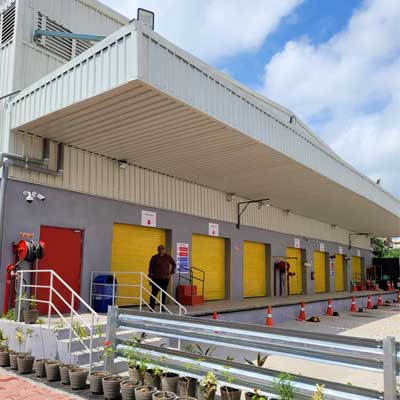India became the world’s second largest consumer of finished steel last year. However, India’s per-capita steel consumption, at 77.2 kg, is still only a third of the 233 kg average worldwide per-capita steel consumption. So, the scope for steel in the country is huge. In the ongoing fiscal, domestic construction, the railways and the capital goods sectors are expected to boost the consumption of steel in India by 7.5 per cent, according to the Indian Steel Association. In the realm of construction, pre-engineered steel buildings will play a role in increasing the uptake of steel for various reasons.
Despite the countrywide need to overcome a mindset that favours conventional construction, Kavi Jain, Principal Architect and Managing Director, Nirman Consultants, expects to see a shift towards pre-engineered buildings (PEBs) in view of the scarcity of labour.
“I expect infrastructure improvements and the ensuing growth of employment opportunities in smalltown India to exacerbate this scarcity of labour and, hence, for construction to increasingly move from the site to the factory,” says Jain.
“The lifecycle value of a PEB will spur a shift towards greater acceptance for the concept,” opines Praful Kava, Managing Director, Jenish Infrawork. “In situations where a landowner wants to develop a structure to be rented out for a limited duration, a PEB is always a better option for returning about half of the upfront cost even at the end of the lifecycle.”
Widening possibilities
Architects can play a significant role in furthering the construction of steel structures, to their benefit.
“Designing a steel building isn’t more challenging than a conventional structure; in fact, it is a great opportunity for architects because there are fewer changes requested by clients once the designs are frozen, as the design detailing done at the outset can accommodate very limited changes after it is delivered to the factory,” says Jain. “This ensures that the design intent is executed as perceived by the architects.”
Whereas pre-engineered steel structures were initially seen to be well-suited to warehouses, today, the concept is being applied to structures serving other uses (see box), entire townships (see box) and even tall buildings (see box).
Jain is working on tall (up to 22 storeys) PEBs for an IT company, a commodity company, and others.
CW showcases a few examples of multi-storey PEBs.
Pre-engineer for perfectly vertical façades
The construction of Epack Prefab’s new corporate office in Noida, a G+17 floor structure, is underway. As Epack Prefab wanted the structure to come up very fast, with a short floor-to-floor cycle, the consulting architect, Kavi Jain, Principal Architect and Managing Director, Nirman Consultants, proposed a pre-engineered steel building to achieve the timelines. “It’s time that we start looking at buildings as machines, in which we live, work and operate,” says Jain. “Construction has to move largely from in situ (on site) to the factory, wherein quality control and precision can be machine like.”
Other advantages of a PEB include its far superior finish to a conventional structure and the ability to construct with less labour onsite as well as the fact that a steel building is greener and more ductile than a concrete building. To explain the advantages that the precise components of a PEB bring to a structure, Jain points out that, nowadays, the facade of structures (also the new Epack corporate building) sees a lot of glass being used and/or plays with natural light phenomena, which is fine as long as it aligns with the solar movement to curtail the consumption of power. “However, while ensuring the verticality of a facade in a conventional structure can be challenging and even necessitate fitting a framework/brackets to overcome discrepancies that can vary from 10 mm to 75 mm, such issues never arise in a factory-made structure.”
The structure will be made of 450 mpa grade of steel, the walls will be made of light gauge steel frame and glass, the floors will be decking sheets, the columns will be composite and the standard height of each floor will be 4 m. Epack Prefab has designed and fabricated the structure.
Pre-engineered for bigger spans and speedy construction
A 10-storey (two basements plus eight floors, each of 1,00,000 sq ft totalling 850,000 sq ft) PEB is coming up in Davangere, Karnataka, to house JJM Medical College. This is a Nikitha Build-Tech project.
“The client opted for a PEB because they wanted to fast-track this project and a PEB would come up faster than a civil structure (the proposed timeline is 21 months),” explains Siddarth Sankar, Principal Architect, Sankar Associates, Coimbatore. “As steel is flexible, a PEB would allow bigger spans up to 24 m. We saw use for a new technology: pre-stressed composite beams. These allowed the number of columns to be reduced by two-thirds as compared to a convention style.”
The built-up column will be made of E 345 grade HR plates, the beam will be ready sections of NPB/UB E 345 grade, the deck slabs will be 120 GSM 1-mm thick GI deck sheets and the fasteners will be HT fasteners of 8.8 grade.
India’s tallest process building is pre-engineered
For a new process building (a spray-dried detergent powder plant) in Sumerpur, Uttar Pradesh, Hindustan Unilever Ltd (HUL) evaluated various construction approaches – RCC, precast and conventional methods – but opted for a PEB from Interarch, an experienced provider that had successfully delivered other HUL projects.
HUL needed a multi-storey building with multiple mezzanine floors to support complex equipment, monorail cranes, and the additional loads of MEP and solar panels. The building needed to combine functionality with economy, high-quality materials and aesthetics. Also, the building was needed fast.
L&T Technology Services, Mumbai, came on board as the project management consultant.
Interarch responded to the mandate by designing a 63-m tall building, India’s tallest process building, with 11 mezzanine floors. The intricate mezzanine floors posed unique engineering challenges to the structural design of the building.
Interarch’s engineering team explored diverse design possibilities, striving to offer cost-effective engineering solutions while maintaining an innovative approach to meet international standards for structural safety and aesthetic design. The end result was a building incorporating built-up box columns with moment resistance frames in both orthogonal directions, a deliberate choice to enhance its robustness. The functional requirements drove live loads that span from 5 kN/m2 to 10 kN/m2.
The structure columns utilised hot-rolled and built-up sections of 345 MPa grade, adhering to the IS code guidelines. Secondary members were composed of pre-galvanised cold-formed members of 345 MPa grade, ensuring compliance with the IS code. The Tracdek Standing Seam Roofing System features a colour-coated galvalume roof sheet equipped with rockwool insulation. Tracdek Hi-Rib colour-coated galvalume roof sheets form the cladding wall. Daylight panels, turbo vents, louvers and other such elements were included to enhance the functionality and aesthetics.
Remarkably, the intricate project was successfully accomplished by Interarch within a mere 90-day timeframe.
Pre-engineering an entire township for speedy construction
The National Thermal Power Corporation opted for PEB technology for an entire township in Tandwa, Jharkhand, the site of the North Kanapura Super Thermal Power Project. PressMach Infrastructure delivered this lumpsum turnkey project (design, supply and erection of pre-engineered residential and non-residential buildings including civil work and internal electricals) in 12 months. If the 150,000 sq ft township had been built conventionally, Sterick Sunny, Director, PressMach Infrastructure, reckons it would have taken anywhere between three to four years to construct. Each building features PUF panel walls and roofs, while the floors are made of cement boards.
Applying light-gauge steel framing to the health sector
Light-gauge steel framing systems are well-suited to rooftop buildings, offices, residences, educational institutions and healthcare centres, and are increasingly being used for these structures.
In Pune, JK Engineering applied the SMARTBUILD® advanced, light-gauge steel framing technology from Tata BlueScope Steel to construct a primary health centre in the Pimpri Chinchwad Maternity Centre-operated Yamuna Nagar Maternity Home.
SMARTBUILD® by Tata BlueScope Steel is made from high-tensile zinc and aluminium alloy-coated ZINCALUME® steel. High precision, strength and safety features, thermal efficiency, superior design and environment-friendly credentials have helped make it a widely accepted construction solution, especially where speedy construction is needed.
The 28.55 m × 9.475 m large structure features the LYSAGHT TRIMDEK® roof system, the LYSAGHT PANELRIB® wall liner system and 50-mm thick rockwool insulation of 48kg/m3 density with aluminium flame-retardant, vapour-barrier facing (FSK) on one side. These materials ensured that the structure is termite and fire-resistant, durable, strong and would cost less to maintain than a conventional structure.
“We had asked for the civil work to be made ready before we stepped in; thereafter, it took just about one month to complete the structure,” shares Nikhil Jangid, Manager, JK Engineering. “The PEB segment has many companies but we work with components that deliver stability and quality outcomes.”




















